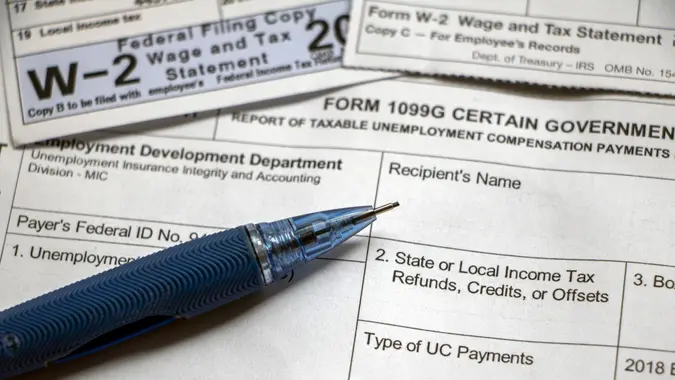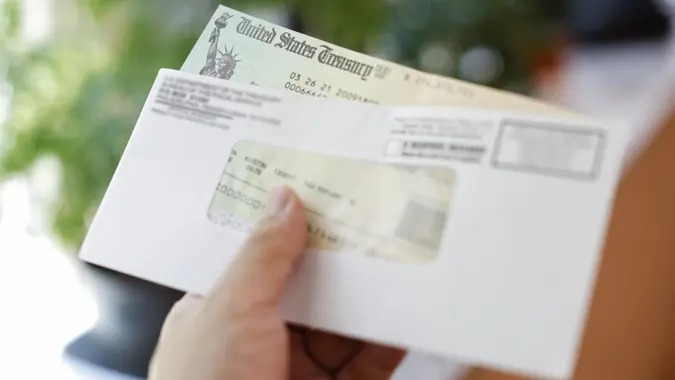5 Ways To Pay Off $20,000 in IRS Debt in Less Than 5 Years

Commitment to Our Readers
GOBankingRates' editorial team is committed to bringing you unbiased reviews and information. We use data-driven methodologies to evaluate financial products and services - our reviews and ratings are not influenced by advertisers. You can read more about our editorial guidelines and our products and services review methodology.

20 Years
Helping You Live Richer

Reviewed
by Experts

Trusted by
Millions of Readers
Life happens. And this sometimes can derail financial plans and put you in a precarious situation. Whether it’s the loss of a job, the inability to save or health issues, there are many reasons why you can end up in debt. Unfortunately, taxes happen too.
And if you owe the Internal Revenue Service (IRS) money, this can be not only extremely stressful, but it also can snowball into even greater debt because of interests.
Yet, there is no reason to panic, and experts said there are steps you can take to pay off $20,000 in IRS debt in less than five years.
“First, make sure you file your tax return timely, as there is a failure-to-file penalty,” said Dr. Lei Han, CPA, associate professor of accounting at Niagara University. “An extension to file is not an extension to pay. A filer is expected to pay taxes by the Tax Day if taxes are owed. Any unpaid tax balance is subject to interest and penalty.”
With tax season underway — it started Jan. 29 — here are some ways to pay off IRS debt, according to experts.
Work With the IRS To Set Up a Short-Term or Long-Term Payment Plan
To get things started, check Form 9465 — installment agreement request — on your tax return, or you can complete an application for an Online Payment Agreement application, said Michael Micheletti, chief communications officer, Unlock Technologies.
“You’ll need to propose a workable monthly payment amount and due date, and you’ll still have to pay monthly interest and late-payment penalties,” he added, noting that you can also contact the IRS to discuss your situation at the organization’s free Taxpayer Advocate Service.
According to Logan Allec, CPA and owner of tax relief company Choice Tax Relief, unless your tax debt is soon “dropping off” — that is, reaching the IRS’ 10-year time limit to collect tax debt — you should be able to propose a payment amount through the IRS’ online system that will pay off your debt in less than five years.
“For example, if you want to pay off your debt in four years — which is 48 months — divide the $20,000 you owe by 48 to get $416, maybe round up a bit to $425 per month to account for future penalty and interest accrual, and propose that amount as your monthly payment to the IRS in the online system,” he said. “As long as you’re making your monthly installment agreement payments, the IRS can’t seize your wages or bank accounts.”
Negotiate With the IRS
Some financial experts argued that you should not hesitate to negotiate with the IRS if you encounter financial difficulties or unforeseen circumstances that impact your ability to repay your debt.
“The IRS may be willing to work with you to adjust your repayment plan or explore alternative solutions,” said Erika Kullberg, attorney and personal finance expert, founder of Erika.com.
For instance, she said, if you experience a temporary financial hardship, you may qualify for a temporary delay or reduction in your monthly payments. Alternatively, if you can demonstrate that your debt is causing significant financial hardship, you may be eligible for an abatement of penalties or interest, she added.
“Be proactive in communicating with the IRS and providing documentation to support your case,” Kullberg said. “Honesty and transparency are key when negotiating with tax authorities, so be forthcoming about your financial situation and any challenges you’re facing.”
Look At Offers in Compromise
If you can demonstrate that paying the full amount of your IRS debt is not feasible given your financial situation, you might qualify for an offer in compromise, said Taylor Kovar, CFP, CEO and founder of Kovar Wealth Management.
“This agreement allows you to settle your tax debt for less than the full amount owed,” he said, noting however, that it requires thorough documentation and can be complex, so consider consulting with a tax professional.
The IRS said it generally approves an offer in compromise when the amount you offer represents the most it can expect to collect within a reasonable period of time.
“Explore all other payment options before you submit an offer in compromise. The offer in compromise program is not for everyone,” according to the IRS.
Review Your Budget
You can also generate the amount you owe by cutting expenses and bringing in additional income. As Unlock’s Micheletti noted, the $20,000 total amounts to a little over $333 a month.
“With discipline, resolve — and some creativity — many households will be able to generate that through a combination of expense-cutting and additional income,” he said.
To cut expenses, start by creating — or updating — a detailed budget, that is, he said, take the time upfront to document every single expense you currently have.
“Once you have that baseline, you can decide what your household can cut back on. It could be a health club membership, streaming services or utility bills,” he added.
Take a Personal Loan
If your credit score is solid and can qualify for a personal loan at a low rate, this may be an option to pay off your IRS debt.
Choice Tax Relief’s Allec argued that currently, IRS debt costs you 8% interest — compounded daily — plus a failure-to-pay penalty ranging from 0.25% to 1% of your unpaid balance per month.
“Although the math is more complicated than this since the interest is compounded daily, that comes out to at least 11% to 20% on an annual basis,” he said. “So if you can take out some other form of credit — such as a personal loan — that can significantly beat that rate, you may want to consider those options.”
More From GOBankingRates
 Written by
Written by  Edited by
Edited by 

























